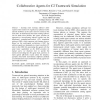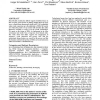370 search results - page 18 / 74 » Supporting Teams in Virtual Organizations |
AGENTS
2001
Springer
14 years 4 days ago
2001
Springer
Through adjustable autonomy (AA), an agent can dynamically vary the degree to which it acts autonomously, allowing it to exploit human abilities to improve its performance, but wi...
ICAI
2003
13 years 9 months ago
2003
– Existing team training software often requires that trainees be organized as physical teams and the members of the same team be trained at the same time. To demonstrate that te...
HICSS
2005
IEEE
14 years 1 months ago
2005
IEEE
This study extends the theory of Recognition Primed Decision-Making by applying it to groups. Furthermore, we explore the application of Template Theory to collaboration. An exper...
CSCW
2006
ACM
14 years 1 months ago
2006
ACM
Mixed Reality Architecture (MRA) supports distributed teams in their everyday work activities by linking multiple physical spaces across a shared three-dimensional virtual world. ...
WOA
2003
13 years 9 months ago
2003
— We adopt a form of group communication, called channeled multicast, for active rooms and other scenarios featuring strict real-time requirements, inherently unreliable communic...


